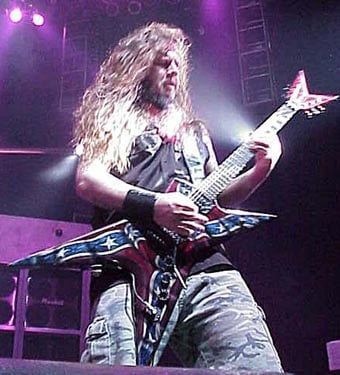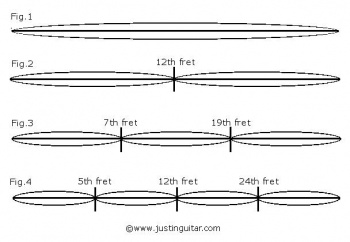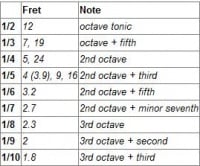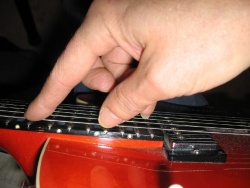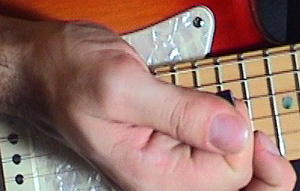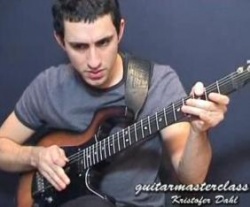Harmonics
Contents |
Harmonics
Harmonics, divided in pinch harmonics and natural harmonics, are guitar techniques used to play high pitch notes. The fundamental of the string is being cancelled and the harmonic rings out. The pinch harmonic can only be done on stringed instruments. In heavy rock music, the pinched harmonic is very much used. In combination with the heavy distortion, it gives a great effect. By using effects, whammy bars, or string bending, all kind of pitches and sounds can be produced. Their identifiable signature was pioneered by rock stars such as Eddie Van Halen and Steve Vai, using whammy bar and high gain, highly distorted amps. Natural harmonics can only be done on the "nodes" of a vibrating string, but pinch harmonics can be used on all positions of the string. The use of harmonics is very important is certain musical styles. Most important in metal, death metal and hard rock. Probably every rock star can do the trick, and people like Zakk Wylde, Dimebag Darrel, Steve Vai, Joe Satriani and Eddie Van Halen all use it very often in their music.
Pitch
Before explaining anything else, it’s important to know the string pitch theory. The pitch of a vibrating string depends on three main factors: string length, tension on the string and the mass density of the string (the weight divided by the length for example). When the string is shortened, the pitch rises. This is what happens when you fret a string or when you use a harmonic, more explanation comes later on this topic. The second factor, string tension, works the same: more tension, higher pitch. When tuning a guitar, the string tension highers or lowers the pitch. The higher the strings density, the lower the pitch. This can be seen on the guitar: the lower strings are thicker then the higher strings.
Naming harmonics
A harmonic has a name, like the second harmonic, or the 4th harmonic. The number in the word says in how many pieces the string is divided when the actual harmonic is performed. So for instance a 7th harmonic means that the string is divided in seven pieces. This is possible between the third and second fret. Another example could be a second harmonic, dividing the strings in two overtones. This can be done by doing a harmonic on the 12th fret.
Natural Harmonics
Physics
Here's the answer. A string is plucked while the finger rests on the low E string. It has to rest exactly above the 12th fret and just lightly touches the string. Now when the string is plucked it will make an "overtone” from the bridge to the 12th fret. There it will have a "node" and then another overtone until the nut, where there is a "node" again. A full vibration is called the fundamental, from the start of the string until then end. The a string can be divided in "nodes", places where the string doesn't vibrate (check the picture for this) Lastly, an overtone is the vibration between two nodes. So again how the natural harmonic on the 12th fret works: the string is plucked and vibrating. It vibrates from the bridge to the 12th fret (first overtone) then there it will have a node, and then the second overtone goes to the nut. As you see, now the string vibrates before the finger and afterwards, but on the same frequency, because the 12th fret is in the middle of the string length. Now when a natural harmonic is done on the seventh fret, the string is divided in three overtones. From the bridge, the first overtone vibrates untill the 17th fret. Then it'll vibrate further on, and this overtone will find his end on the seventh fret. Now the string is divided in three equal parts. As you can see, the harmonic on the 17th fret is the same as the harmonic on the seventh fret. This is because the nodes are on the same place, and the string is divided in three equal parts with both seventh and 17th fret harmonics. The pitch difference between the fretted and the harmonized note can be explained aswell: when the string is fretted, the vibration length is from the bridge to the seventh fret is around 40cm. This means the vibration length is 40 cm. When the note is played harmonized, the string is divided in three equal parts of 20cm each. So the vibration length is much shorter. This is what causes the higher pitch. Natural harmonics can’t be done on every position, because the position has to divide the string in equal lengths, and the position has to be on a node. There are a lot of these positions, and they do not have to sit above a fret.
How to use them
When you want to make a natural harmonic, here’s a step by step guide:
-Find out what harmonic you want to play. For beginners it’s recommended just to start on the 12th fret on the low E string. This is the easiest harmonic, sometimes harmonics are quit hard to make.
-Put a finger (e.g. the index finger) on the place where you found the harmonic.
-Now make sure the finger “lays” on the string; it’s important to have the touch as soft as possible. When you push to hard, the finger touches more that only the node, and the harmonic will be muted
-Pluck the string and listen to your harmonic
-Optional: the higher harmonics (G string, third fret for instance) it sounds very cool to use
some whammy/tremolo movement there.
Natural harmonics are used in solo’s, but not very common. It’s pretty hard to play harmonics in a part, first of all because making the harmonic can be hard itself. Mostly the 12th fret harmonic isn’t used (it gives the same sound as the fretted one, so why play the harmonic) so the higher ones are used. These are pretty hard to play. It’s also hard because when playing fast stuff, the fingers move pretty aggressively, for a harmonic it’s important the fingers make a very gentle movement. This can be hard.
-Are you sure you are on a good position? Above the 12th fret is always right. The sound is the same as the fretted note, but as long as you don’t fret the note and still here a sound, you can tell it’s a harmonic.
-Maybe you push to hard? On the 12th fret, lay the finger on the string and pluck it with your pick or your finger.
If it still doesn’t work, make sure you talk about it with someone who knows how to make natural harmonics
Related GMC lessons
natural harmonic bass lesson
Pavel’s harmonics lesson (contains natural and artificial harmonics).
Artificial Harmonics
The artificial harmonics are often used in the heavier music genres such as hard rock, metal and death metal. Those genres should give a good picture of what kind of genres are meant here. The artificial also uses the string vibration as explained in the previous part. There are different versions of the artificial harmonics, this text contains the “pinch harmonic” and the “standard” artificial harmonic. To clear this up right now, when I talk about artificial harmonics, I mean all the artificial harmonics or the “standard” one. Artificial harmonics have one tiny problem, which is that they sound way softer then normal notes. This is why the technique isn’t used often in acoustic playing. The best “cure” against this, is having some distortion on the amp sound. With enough distortion, the volume difference with normal notes is very low.
Physics
Artificial Harmonics
The artificial harmonics also use the string vibration, and pitch theory. The string vibrates from node to node. For example a string is fretted on the 12th fret: the string vibrates from the bridge until the 12th fret. So the nodes are at the start (bridge) and at the 12th fret. There are only two nodes. The harmonic means, putting a finger on a certain place (e.g. 12th fret again) and let the string vibrate further, after the finger. This means the string has a node at the bridge, vibrates until the 12th fret where it has a new node, and then vibrates until the nut where the last node is. The more times the string is divided, the higher the pitch (following the pitch theory).
Now what happens with artificial harmonics is that the nodes aren’t on their natural place. With this I mean it becomes possible to do a harmonic on every place on the fret board because of freedom of the nodes. For instance, the artificial harmonic is done with one finger fretting a string. Another finger now touches the node and the sting is plucked. The node was moved from it’s original position because of the fretted note. This means, the string has first been shortened, due to the fretting, and then harmonized. This technique still has some limitations, for instance the distance between the fretted note and the place of the finger has to be calculated. For instance, when I fret on the second fret, and I put my finger on the 14th fret (one octave is 12 frets) the harmonic is the same note as the fretted one, but one octave higher. This means, when I would have put my finger on the 13th fret, there was no harmonic at all, there is no node there.
Pinch Harmonics
The pinch harmonic is a harmonic made by the thumb. The pick picks the string, and directly afterwards, the thumb lightly touches the string, causing a harmonic. Here a note can be fretted as well, making the harmonic artificial. The node is moved by the fretting finger, and then the thumb hits one of the nodes in the picking area. Also here the played harmonic, will be higher when the note is fretted higher, and when the pick is closer to the bridge. When we relate this to the natural harmonic, we can see it’s the same principal. The string is vibrating until the last node (here it’s the fret, with the natural harmonic it’s the nut). Now if we concentrate on the thumb action, we can see that the thumb only slightly touches the string. The place where the thumb hits the string is very important because that is where a node should be. The pinch harmonic can’t be done one every place (with the picking hand). This is again because of the placement of the nodes. When the string was divided in two parts, there were three nodes (only one on the fret board), now when we play a higher pitched harmonics (e.g. the pinch harmonics) the string is divided in much more overtones and by that, the string also has much more nodes. This is why there are so many possible harmonics in the little space between the bridge and the start of the fret board. The limitation of only being able to do a harmonic on certain frets, is gone now. The nodes are so close, that you don’t have to count them out. This also means that if we want to get a specific note, we have to play the pinched harmonic at the right spot to get the right amount of overtones. The easiest place to do a pinch harmonic would be somewhere on the D or G string. This is because of the string tension, the higher strings have a higher tension (making it harder to do the pinches) and the lower strings have a lower tension (also making it harder).
How to use
Artificial Harmonics
The artificial harmonic is not hard to make once you master the natural harmonic, here’s a plan:
-Fret a note and calculate on what note you want to place your right hand finger
-Put a finger from the right hand on the place, where you want it. (e.g. fretted at second fret, place the finger at 14th fret for a full octave higher)
-Pick the note
Pinch Harmonics
Firstly, I’ll explain how to make a artificial harmonic on a standard, 6-string guitar. Of course this technique is also possible on 7-string guitar or on any other stringed instruments with frets. Afterwards, I’ll move on and concentrate more on the thumb movement.
I’m going to start out with the easiest and unofficial way of making a pinch harmonic. This way is not conventional to use in your playing, but is very nice to start out with. It will give you an idea of how it will sound and what you are doing when you get to the real pinches. Here’s a plan:
-Fret a note, easiest is on the G or D string
-Pick the note with your pick
-Let the note ring, and now gently let the side of the thumb hit the string. It’s important to do this very slowly so you won’t mute the string
-When the beep starts (it might be hard to hear without some distortion) remove the thumb and let the harmonic ring.
Now here is a plan for the “real” way of doing a pinch harmonic. It’s hard to do and controlling it is even harder. If it doesn’t work the first time, just keep trying. It’s important to do the version described above, if you can’t manage to do this version. Also mind the distortion, it needs to be cranked up if you want to hear the harmonic clearly. Make sure the distance between the edge of the pick and the thumb is very short (e.g. 3mm).
-Fret a note, again the D and G string notes are the easiest to start on.
-Pick the note and directly afterwards let the side of the thumb hit the string
-Directly after hitting, the thumb needs to move. It’s important not the let the thumb rest on it’s place, muting the string.
The thumb plays a very big role in the technique. First of all, make sure the distance between the tip of the pick and the side of the thumb is no more then 3-4mm. It’s very important to do what’s called a “digging motion”. The pick goes against the string, just before picking it, and then makes a movement like it wants to dig under the string. Now let the pick come up, so that the string is picked from beneath (the pickup side). In this way the thumb will probably hit the string for a brief moment, just enough to get the harmonic ringing.
On this page, Justin Sandercoe (from justinguitar.com) shows how to do a pinch harmonic, but he also explains the practicing harmonic, explained above.
Related GMC lessons
Trond’s harmonics lesson
Zakk Wylde style pinch harmonics, by Gabriel Leopardi.
Pavel’s artificial and natural harmonics lesson
Theory in practice
Those physics all sound great, and make it look fairly simple, but there still is something which has to be added to this story. The fact is then when playing a harmonic, we actually play a bunch of harmonics. A selection of them. When you play the G note on the open string, there are only 2 nodes. The unmoveable bridge and nut nodes. This let’s all the harmonics ring out, the second, third, 7th etc. This is because of the fact that all the nodes are free, the harmonics aren’t prevented from ringing in any way.
When you play a harmonic you don’t want all the harmonics to ring out, you want to get the right selection of them. For instance when we play a harmonic on the 12th fret, the fundamental can’t ring out because it has no node on the 12th fret. Other harmonics, like for instance the 4th will ring as well because they have a node on the 12th fret. If you study the list of harmonics, you’ll find out that all the even harmonics have a node on the 12th fret. It’s important to remember that the named harmonic, here it’s the second one, has the dominating tone. You don’t realy hear the 4th harmonic ring very clearly, but it is there.
On the other hand, harmonics like e.g. the 5th harmonic can’t ring. They are cancelled because they don’t have a node on the 12th fret. Knowing this, it might be logic to see that the sound from playing a harmonic is a much purer tone than the open string. This is because of the fact that the harmonized note only uses the “good” harmonics while the open string used all the harmonics possible, also the ones who didn’t have the right sound.
Now you can see why playing a harmonic is actually making a selection of harmonics. This counts for artificial harmonics, as well as for natural harmonics.
More types of harmonics
There are a bunch of other types of harmonics, not described in this text. I have described the artificial harmonic, the pinch harmonic and the natural harmonic, and here two new harmonics will be described: the Tap harmonic and the Whammy bar harmonic.
The Tap Harmonic:
The tap harmonic is uses the same technique as the artificial harmonic, only here you just touch the string for a very short amount of time. Here’s a plan for this technique:
-Think on what frets you want to make your artificial harmonic.
-Place the fretting finger in the correct fret.
-With the artificial harmonic, we now put our other finger softly on the string. In this case we only touch it briefly. It’s very important not to fret, which can be hard with such a fast motion.
The Whammy Bar Harmonic:
The whammy bar harmonic is one of the hardest harmonics to perform. The finger whips on the place of a node. The node has to be not on top of a fret. Before performing the whip, the whammy bar is pushed down, and afterwards the whammy goes up again. This gives a very cool and crazy scream. Here’s a little plan again:
-Push down the whammy bar.
-Whip the string with one of your fretting fingers, a good place for this might be between the 2nd and 3rd fret on the G string.
-Let the whammy bar come up and use it for some heavy vibrato.
Related GMC lessons
Eddie van Halen style (contains tapped harmonics)
The motto is oops, starts out with some Whammy bar harmonics
Hardware settings
When you want to produce a harmonic (especially with pinch harmonics), your hardware setting can be very important. The pickup selector, gain control and gain are the most important variables when you want to get an easy pinch harmonic. The pinch harmonic gives a very high, thin sound. This is what you could call a sound with a lot of treble in it. The best way to pick this sound up is using the bridge pickup. This is because the bridge pickup is the most aimed to pickup high, trebly sounds. This can also be seen when just playing normal. Try and switch your pickup selector a bit. After a while you’ll see that the neck pickup picks the more bass-like sounds up, while the bridge pickup concentrates more on the treble sounds. The second important thing is the treble setting itself. The higher this setting goes, the more trebly your harmonic will sound. If we look back at the bridge pickup picking the trebly sounds up, we can say that the more treble you put in the sound, the easier it’ll be for the pickup to pick up the sound. And that’s what these settings are all about, picking up the harmonics sound in a good way. The last important setting is the gain setting. The pinched harmonics have a very low volume, meaning that the amp has to crank it up in order to get a descent sound. Wit the gain control you can do this. The heavier your distortion is, the easier the harmonic will ring.
Harmonics in musical notation
In tab, the symbol for a harmonic is <>. When there is only the <> sign, it often means pinch harmonic. If there is another type of harmonic involved, it's possible to write the abbreviation (e.g. NH means natural harmonic). Here's a little example form Pavel's Artificial and Natural harmonics lesson
NH E||-------------------------------------| B||-------------------------------------| G||--<>9--------------------------------| D||--------<>7---<>9--------------------| A||--------------------<>7---<>9--<>10--| E||-------------------------------------|
Here some pinch harmonics are played and one natural harmonic.
It's also possible to notate a harmonic in official music notation. Harmonics get a diamond shaped figure above the note, and for every type of harmonic there's a diffrent notation. In tab there's no sign that tells whether they mean a full octave (second) harmonic or any other harmonic. With the official musical notations this is possible.
Outro
All in all the harmonics are a hard thing to use on guitar. But after learning it, a new world opens and the reach (pitch wise) of the guitar gets a lot wider. I hope this text has helped you out a bit and good luck practicing.
--Kaznie 13:26, 3 July 2008 (CEST)



